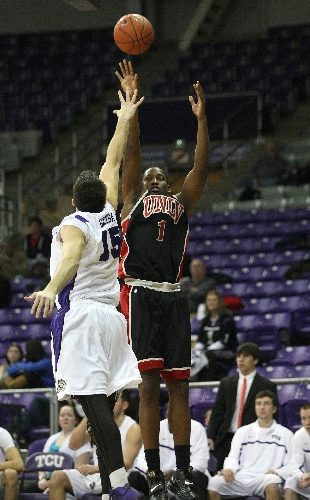Three-pointer outlasts critics, adjusts strategy
One of the most significant changes in college basketball history was met with disdain, called a novelty, even silly.
Down in the desert, not far from where fortunes can be won or lost with the flick of a wrist, a rebel leading a bunch of Rebels was among the handful of coaches who embraced the new rule.
Not only did UNLV's Jerry Tarkanian like the 3-point shot, he saw it as a game-changing weapon and had his players cast 'em up whenever they got a chance.
And the Rebels haven't missed since, hitting at least one in every game -- 796 and counting.
"We're a team that shoots a lot of 3s over the years," current UNLV coach Lon Kruger said. "We've probably been attempting fewer this year than we have over the last few years but still shoot it pretty freely from 3."
It has been 25 years since the NCAA instituted the 3-point shot amid harsh criticism from coaches across the country.
Look at it today, and it's hard to imagine the game without the arc.
The 3-point shot has, after a few get-a-feel-for-it years, become as much a part of the game as the dunk, adding excitement while altering everything from recruiting to the way basketball is played and coached at all levels.
"The 3-point line is very popular; it's here to stay," said Maryland coach Gary Williams, among those initially reluctant to add the arc. "It has changed the game."
An argument can be made that the 3-point shot is the most significant change in the modern era of college basketball.
Other than repealing the dunking ban in 1976-77, adding the shot clock in 1985-86 and perhaps freshman eligibility in 1972, no other rule change has affected college basketball as much since the game's early days, when they were cutting off the bottom of the nets so the ball could go through and moving the backboards out so players couldn't jump off the walls.
While the dunk has more wow-power, the 3-pointer is more of a power shifter.
By adding a point, the 3-point shot made the game more entertaining by spreading the floor and creating more chances to get into transition off long rebounds.
It gave trailing teams a no-lead-is-safe hope they might not have had going two points at a time; leading teams wield a spirit-crushing dagger.
It forced coaches to alter tactics, getting their players to guard the entire floor instead of just clogging the lane.
It expanded players' skill sets -- everyone, including the biggest ones, learning how to shoot from the perimeter.
Trey, triple, trifecta -- whatever you want to call it, the 3-pointer has reshaped basketball for good.
"It's more exciting because of the 3-point shot," said Louisville's Rick Pitino, one of the first coaches to embrace the shot. "There's much more strategy to the game offensively and defensively because of the 3-point shot."
The NBA adopted the 3-point shot in 1979, and it had been an experiment in numerous college conferences before the NCAA added it in 1986.
Before the arc was installed, teams were set if they had a dominant center, such as Georgetown with Patrick Ewing and Virginia with Ralph Sampson.
These days, the game has stretched, making the perimeter player as important as the post player. Nearly everyone on the roster can shoot from downtown, even players 6 feet 9 inches and taller, something unheard of in the pre-arc days.
It has changed recruiting, too.
Coaches aren't always looking for that beefy center, not just because so few are out there now but because they want multitalented players who can fit into a college game that has put a premium on ball-handling and long-range shooting.
"Every team basically plays three guards, and a lot of teams are going to almost a fourth guard that's 6-5 or 6-6 and can shoot the ball to take advantage of the 3-point line," Williams said.
At UNLV, Tarkanian had his team shooting 3s in the first game of the 1986-87 season, and the coaches who followed have kept the Rebels firing them up.
They're proud of the monumental streak at UNLV, but once the ball goes up during a game, the Rebels don't pay much attention to it.
The crowd, though, is aware of when the streak is in jeopardy, buzzing and calling for 3-pointers when it's late in the game and the Rebels haven't made one, including a couple of times this season.
"When it starts getting late in a game and we haven't made one, the crowd is very much aware," said Kruger, whose team hit 11 3s in a rout over Texas Christian on Wednesday night. "They're encouraging 3-point attempts, very much."
Just like everyone nowadays.






















